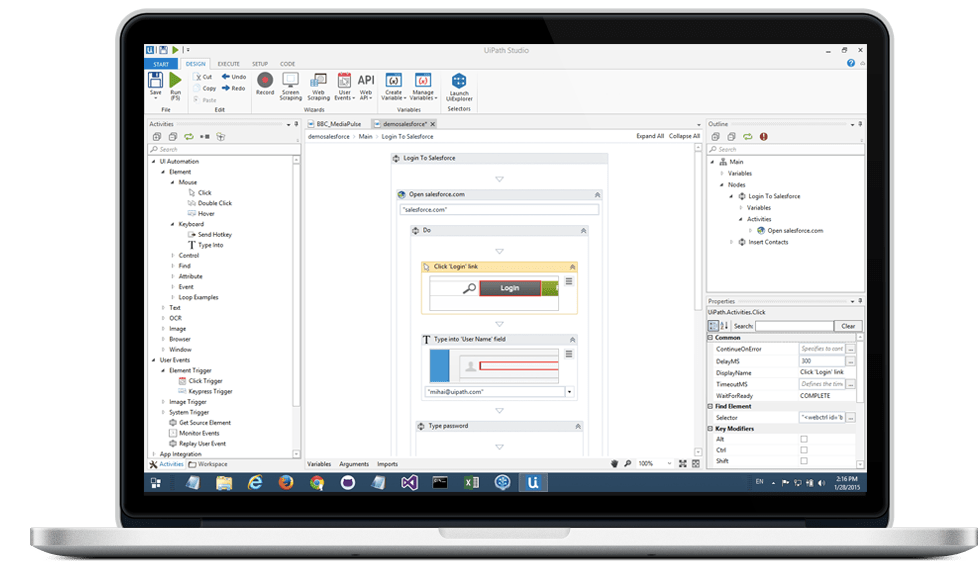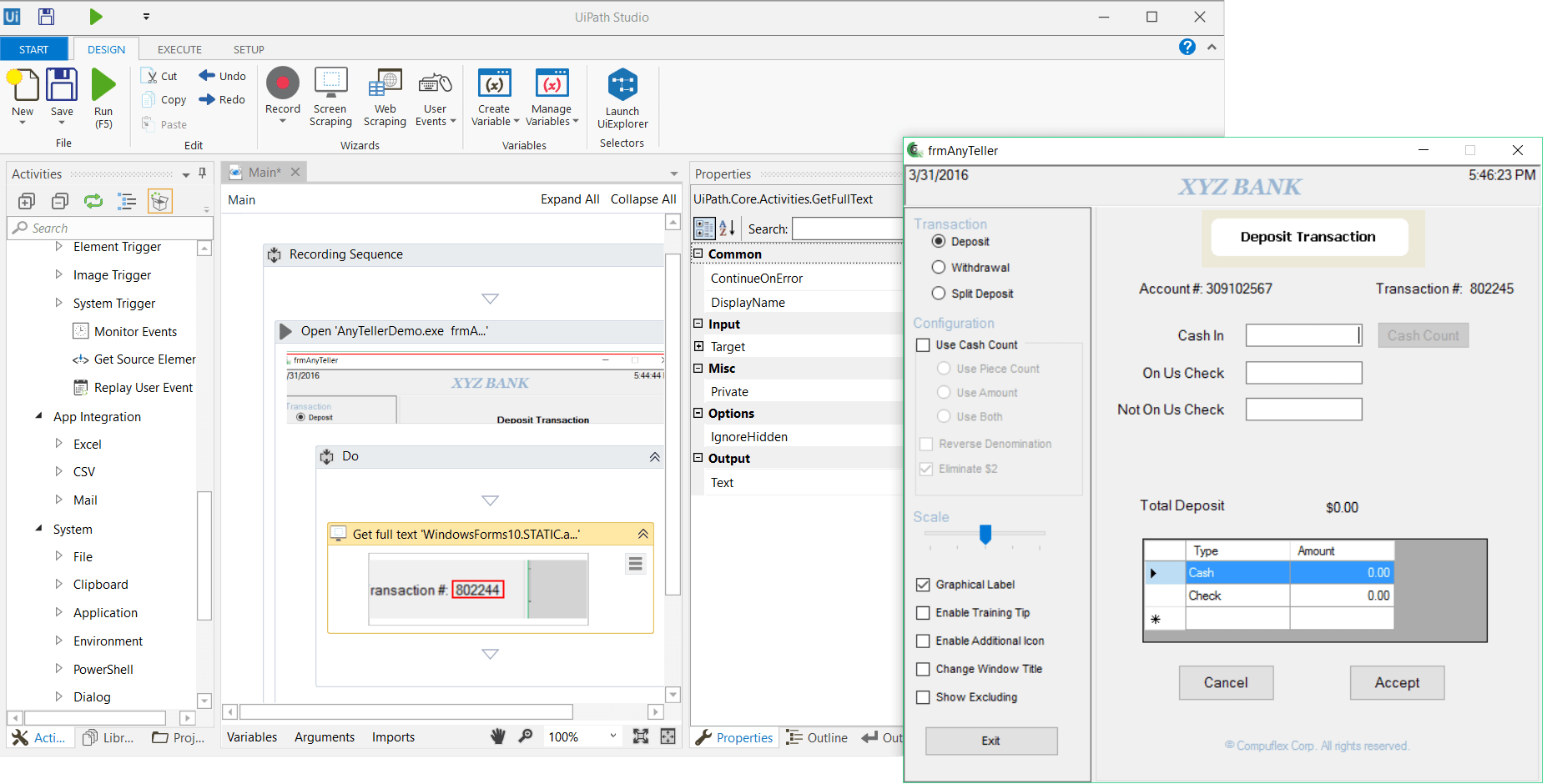Robotic process automation (RPA) startup UiPath today announced it has closed a $225 million funding round, bringing its total raised to over $1.2 billion. While the new round is roughly half the $568 million UiPath raised last April, it catapults the New York-based company’s post-money valuation to $10.2 billion, up from $7 billion in 2019 and $3 billion in 2018.
CEO Daniel Dines says the funding will be used to scale UiPath’s platform and deepen its investments in “AI-powered innovation” as it expands its cloud software-as-a-service (SaaS) offerings. The round will also likely lay the groundwork for future strategic deals, following UiPath’s acquisition of startups StepShot and ProcessGold last October.
RPA — technology that automates monotonous, repetitive chores traditionally performed by human workers — is big business. Forrester estimates that RPA and other AI subfields created jobs for 40% of companies in 2019 and that a tenth of startups now employ more digital workers than human ones. According to a McKinsey survey, at least a third of activities could be automated in about 60% of occupations. That may be why Market and Markets anticipates the RPA market will be worth $493 billion by 2022, with a compound annual growth rate of 19%.
UiPath was founded in 2005 by Romanian entrepreneur Marius Tîrcă and Dines, a former Microsoft software engineer. The company was headquartered in Bucharest before setting up shop in New York City and expanding to London; Bangalore; Paris; Singapore; Washington, D.C.; and Tokyo. UiPath grew its client base from 100 customers in 2017 to over 5,000, with more than 750,000 users as of last year. Moreover, UiPath says the solutions developed by its over 2,800-person workforce now automate tasks for more than 65% of the Fortune 500 and eight of the Fortune 10, including GE, Virgin Media, Airbus, Google, Autodesk, NASA, HP, Fujifilm, McCormick, DHL, Swiss Re, McDonald’s, and Equifax.
UiPath takes a multipronged approach to RPA that begins with task discovery. The company’s process mining tech produces an “X-ray” of end-to-end desktop, web, text-based, business apps, email, IT, and office workflows by pulling log data from existing enterprise systems, helping identify root cause issues through recommendations, visualizations, tags, and KPIs. Task capture is the next step in UiPath’s onboarding chain and comes as employees move through a work process they’d like to automate, taking screenshots and gathering data like window names, titles, and descriptions before pulling everything together into a process definition document or XAML file.

Task mining complements process mining and capture by identifying and aggregating workflows. UiPath applies AI to map tasks to automation opportunities and tease out the most frequent patterns from the data, securely recording metrics from whitelisted applications, including steps and execution time. Thanks to AI-powered document understanding capabilities, the platform can ingest, analyze, and edit PDFs and images — even those with handwriting, checkboxes, signatures, rotated or skewed elements, and low resolutions. When used with UiPath’s Orchestrator product, task mining can be provisioned, deployed, triggered, monitored, measured, and tracked at every step from a browser or smartphone.
A robust set of computer vision algorithms underlies UiPath’s document understanding features, which can recognize and interact with on-screen fields and components like Flash and Silverlight. Drawing on a neural network with a combination of screen optical character recognition and text fuzzy matching with a multi-anchoring system, the Linux, Android, and Windows software robots powered by the algorithms can “see” virtual desktop interfaces via Citrix, VMWare, Microsoft RDP, and VNC clients and enable automations with dynamic elements like drop-downs and checkboxes.
UiPath offers three kinds of robots: attended robots that await directions, unattended robots that don’t require human intervention, and hybrid robots that finish daily tasks with the help of attended robots and leave the unattended robots to compile reports. From a dashboard dubbed Action Center and Insights, IT teams can view up to thousands (or tens of thousands) of robots’ tasks and supporting documents and take remedial actions in the event of a bottleneck.
The beating heart of UiPath’s suite is the Automation Hub, a portal from which employees can earn rewards for contributing automations. It’s also where admins can see automations and control them from idea to production, leveraging an algorithm to identify tasks worth automating. And it’s where members of the C-suite can visualize automation complexity and payback costs. UiPath Studio provides a toolset developers can use to record workflows, borrow prebuilt automation activities, integrate third-party components, and share and reuse components, with a package feed manager that ensures uniform sources and workflow analyzer rules that establish development paradigms.
Orchestrator facilitates these administrative tasks with zero-touch provisioning, pluggable enterprise credential stores, and the ability to add processes by adding users to Active Directory groups. Another product, called AI Fabric, aids with AI and machine learning lifecycle management. Using AI Fabric, customers can import their own models or choose from a library of prebuilt options, and they’re able to keep tabs on retraining and versioning through a test suite with drag-and-drop interfaces for test planning, requirement traceability, and defect reporting.

Above: UiPath Studio for designing processes
UiPath’s work has gained attention during the coronavirus pandemic. The company told VentureBeat that in Dublin, the Mater Hospital is using its RPA tools to process COVID-19 testing kits, enabling the hospital’s onsite lab to receive results in minutes and saving the nursing department three hours per day, on average. In the U.S., the Cleveland Clinic leveraged a UiPath product to execute a series of patient intake tasks in 14-16 seconds, versus the 2-3 minutes it took a human. UiPath also claims to have assisted with U.S. government automation efforts around COVID-19, for instance helping the Department of Homeland Security use 500 bots to perform coronavirus-related data analysis. Among other agencies, the Department of Veterans Affairs is investigating how it might apply RPA tools to its environment.
UiPath might have momentum on its side — annual recurring revenue hit $400 million this year, an uptick from $300 million in October 2019 and $25 million three years ago. But it also has rivals in Automation Anywhere, which last secured a $290 million investment from SoftBank at a $6.8 billion valuation. Within a span of months, Blue Prism raised over $120 million, Kryon $40 million, and FortressIQ $30 million. Tech giants have also made forays into the field, including Microsoft’s acquisition of RPA startup Softmotive and IBM’s purchase of WDG Automation.
Competition and other headwinds forced UiPath to lay off 300 to 400 employees (roughly 11% of its workforce) last year in what it characterized as a move toward efficiency. (It remains to be seen whether the company will move forward with the initial public offering it reportedly planned for the next year or so.) UiPath’s competitors haven’t been immune either — Automation Anywhere has let go of 10% of its workforce as it adapts to stronger demand for cloud services motivated by the pandemic, and FortressIQ says the current economic climate has slowed the growth of its 70-person workforce.
Alkeon Capital Management led today’s series E, with participation from Accel, Coatue, Dragoneer, IVP, Madrona Venture Group, Sequoia Capital, Tencent, Tiger Global, Wellington, and funds and accounts advised by T. Rowe Price.